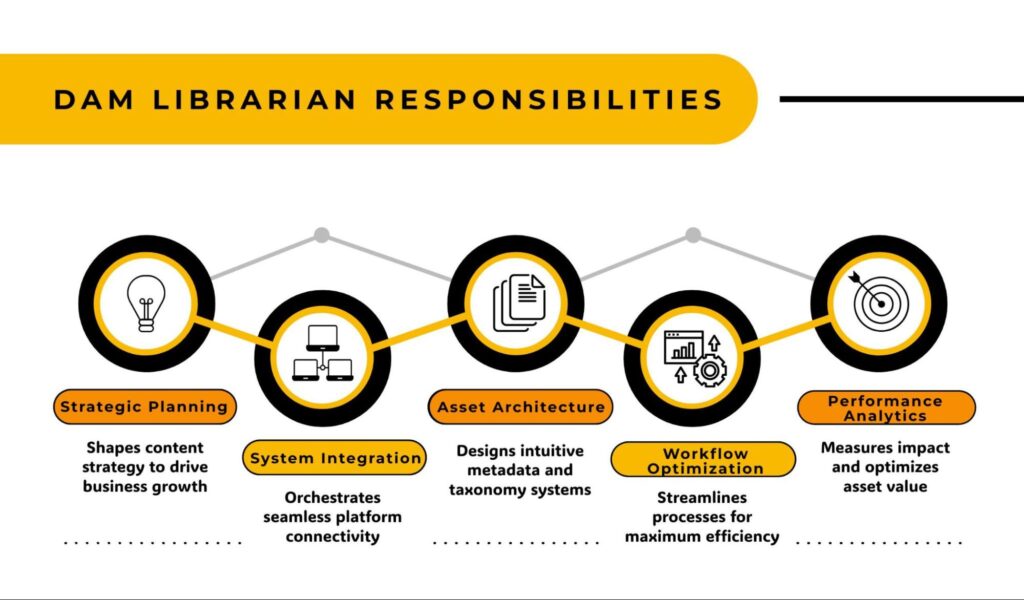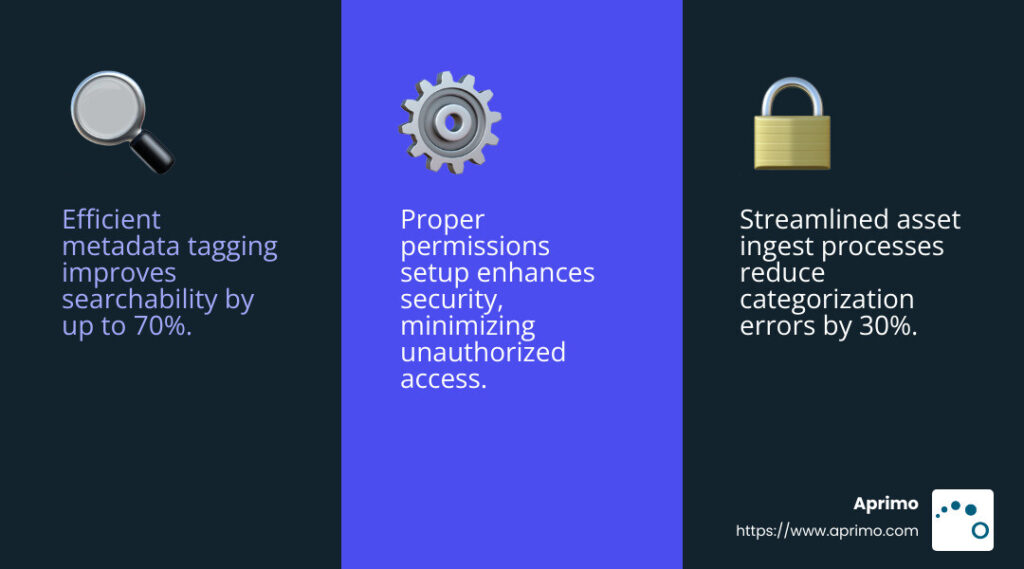Modern companies manage thousands of images, videos, documents, and brand assets. Therefore, having a dedicated digital asset librarian is becoming essential. Digital asset management (DAM) librarians bring organization, accessibility, and control to vast digital libraries, ensuring that content is easy to find, use, and repurpose.
With recent reports showing that as much as 70% of digital content goes unused due to poor organization (according to Forrester), a digital asset librarian can make a significant impact on efficiency and productivity.
Explore the key reasons why a DAM librarian is invaluable for managing and maximizing the value of your organization’s digital assets.
What Is a Digital Asset Librarian and Why Do You Need One?
A DAM librarian is a strategic professional who manages, organizes, and optimizes an organization’s digital assets while playing a crucial role in content operations and go-to-market strategies. Their expertise spans traditional asset management and modern technical proficiency across complementary systems like Content Management Systems (CMS), Product Information Management (PIM), and Marketing Resource Management (MRM).
As digital content libraries expand, these professionals ensure assets are not only well-organized and accessible but also leveraged effectively across the organization’s tech ecosystem to maximize value and reuse.
Key Responsibilities of a DAM Librarian:
- Strategic Content Operations: Develops and maintains efficient workflows for asset usage and reuse, contributing to broader go-to-market strategies and content optimization
- Technical Integration Management: Coordinates asset management across integrated platforms like CMS, PIM, and MRM systems to ensure seamless content operations
- Organizing and Cataloging Assets: Implements metadata strategies and taxonomies for quick, accurate asset discovery
- Access Control and Compliance: Manages permissions and ensures assets meet quality standards and regulatory requirements
- Training and System Optimization: Educates teams on DAM best practices while continuously improving system efficiency
Why Your Business Needs a DAM Librarian
Modern organizations require DAM librarians to bridge the gap between content management and strategic business objectives. Without their expertise, companies risk inefficient asset utilization, disconnected systems, and missed opportunities for content optimization.
A DAM librarian ensures assets are not only organized but strategically deployed across channels and platforms, maximizing ROI through effective reuse and distribution strategies. Their understanding of both content management and technical systems enables seamless integration of assets into broader marketing and business initiatives.

A digital asset management librarian is the backbone of any organization dealing with a large volume of digital content. By expertly managing assets, they improve productivity and protect the organization’s investment in its digital resources. Through their meticulous work in metadata, taxonomy, and rights management, they ensure that digital assets become valuable resources that drive the business forward.
Benefits of Having a Digital Asset Management Librarian
A DAM librarian’s responsibilities are tailored to an organization’s unique needs, influenced by factors such as the business’s size, the number of users and assets, and governance requirements. Overall, a DAM librarian plays an essential role in ensuring that digital assets are organized, accessible, and aligned with brand standards, making the most of a company’s content library.
Enhancing Asset Findability
One key benefit of a DAM librarian is the ability to streamline asset findability, ensuring that team members can quickly locate the resources they need. This involves reviewing and approving or rejecting assets from all contributors, whether internal users or external partners like agencies.
DAM librarians conduct regular audits of assets, checking metadata and branding to ensure that all files meet company guidelines and that contributors adhere to established processes. By maintaining clear guidelines for asset tagging, metadata, and organization, DAM librarians boost compliance with branding standards and improve the efficiency of asset discovery for users across the organization.
Internal Search Capability: A DAM librarian sets up systems that make finding digital files a breeze. They ensure that assets are tagged with the right metadata, which acts like a roadmap for your digital library. This means less time searching and more time using assets effectively.
Metadata Tagging: DAM librarians create robust metadata schemas to allow precise search and retrieval. When you search for an image or document, you’re more likely to find exactly what you need quickly. As a result, your team can focus on their core tasks rather than wasting time hunting for files.
Asset Utilization: When assets are easy to find, they get used more, boosting productivity and ensuring that the investment in creating digital content is fully realized. Teams can repurpose existing assets instead of creating new ones from scratch, saving time and resources.
Streamlining Asset Management Processes
A digital asset librarian also plays a vital role in refining asset management processes, working closely with DAM product owners and tech support to keep documentation updated and user-friendly. They actively participate in governance meetings, offering insights on asset usage, vendor licensing, and overall DAM system performance. Their involvement in managing vendor relationships includes activities such as reviewing vendor contributions, overseeing licensing renewals, and conducting periodic licensing audits.
DAM librarians can also run detailed reports on key performance indicators (KPIs) like asset approval rates and downloads, helping departments gauge the impact and value of their digital assets.
Asset Ingest Processes: DAM librarians streamline how assets enter the system. They develop controlled vocabularies to maintain consistency, ensuring that every asset is categorized correctly from the start. This reduces errors and speeds up the ingest process.
Permissions Setup: Security and compliance are crucial. A DAM librarian sets up permissions and controls, ensuring that only authorized users can view or download assets. This minimizes risks and keeps sensitive information safe.
Tool Administration: Acting as the administrator, the DAM librarian ensures that the digital asset management system operates at peak performance. They work closely with vendors to resolve issues, implement updates, and align the tool with organizational needs.
With a DAM librarian in place, businesses can rely on a dedicated expert who ensures that assets are used effectively, aligns teams with branding and compliance standards, and maximizes the value of their digital content library.

Who Needs a DAM Librarian, and What Skills Are Required?
A digital asset librarian is invaluable for organizations with large, complex digital asset libraries—think global brands, media companies, marketing agencies, or businesses with extensive eCommerce catalogs. Any company that regularly produces, shares, and updates content across teams, departments, or regions can benefit from having a DAM librarian manage the structure, organization, and accessibility of these assets.
For example, a retail brand with thousands of product images, seasonal marketing materials, and brand guidelines needs a DAM librarian to ensure that each team can quickly locate and use the right assets. Similarly, a media company producing video and photo content for multiple campaigns would rely on a DAM librarian to maintain consistent tagging, manage asset permissions, and ensure content is accessible yet secure.
A DAM librarian must possess a unique blend of organizational skills, technical knowledge, and communication abilities. Key skills include:
- Metadata Management: A DAM librarian must be skilled in creating and managing metadata structures, tagging systems, and naming conventions. This ensures that assets are easily searchable, especially when hundreds or thousands of files are involved.
- Attention to Detail and Brand Compliance: DAM librarians conduct regular audits to ensure brand consistency across assets, preventing off-brand or outdated content from being used. For example, in the fashion industry, where brands constantly refresh seasonal campaigns, a DAM librarian ensures that only current assets are accessible for marketing use.
- Technical Skills: Familiarity with DAM platforms and digital asset workflows is crucial, as DAM librarians often work closely with IT and digital teams to optimize the system. For instance, an agency DAM librarian may need to troubleshoot access issues, manage user permissions, or integrate the DAM system with other tools.
- Project Management and Collaboration: A DAM librarian frequently collaborates with marketing, design, and brand teams to align on content strategy and asset requirements. In a healthcare organization, for instance, the DAM librarian may work with compliance officers to ensure that all images and patient-related documents meet regulatory standards.
Ultimately, companies that rely on high volumes of digital content need a DAM librarian to organize and streamline asset workflows, maintain brand integrity, and ensure assets are always available and accessible for maximum impact.
Why Is a DAM Librarian so Crucial for Brands and Organizations Today?
With the exponential growth of digital assets—ranging from product photos and videos to documents and presentations—effective management is key to ensuring assets are easy to find, consistent with brand standards, and legally compliant. A DAM librarian not only organizes these assets but also leverages AI tools within the DAM system to automate tagging, streamline search capabilities, and enhance overall asset discoverability.
Applications in eCommerce
For example, in an eCommerce company managing thousands of product images, a DAM librarian can use AI-driven auto-tagging features to assign accurate, descriptive metadata to new images, making them instantly searchable. AI capability dramatically reduces the time spent manually tagging assets, ensuring that every item in the DAM is correctly labeled and easy to locate for the marketing and sales teams.
How Entertainment Uses DAM Librarians
In the media and entertainment industry, where content volume and turnover are high, a DAM librarian is instrumental in managing the lifecycle of assets, from creation to expiration. Using AI-powered predictive tools, the librarian can set up automated workflows that alert teams when content is nearing its expiration date or requires updates.
A proactive approach ensures that outdated content is archived, and only the most relevant assets are accessible, which is critical for maintaining brand consistency and compliance with licensing agreements.
Digital Asset Management for Globalized Organizations
For global brands with teams spread across multiple regions, a DAM librarian ensures that content is localized and relevant. Leveraging AI-driven insights, they can identify which assets perform best across different markets and prioritize those for future campaigns. A data-driven approach to asset management improves efficiency and empowers teams to make more strategic decisions with content.
Adaptability Through Integrations
Digital asset librarians must be highly adaptable, as their role often involves navigating a constantly evolving digital environment. With the rapid pace of content creation and the growing need for efficient collaboration across departments, a DAM librarian must quickly adjust workflows, adopt new technologies, and respond to shifting organizational needs.
Integrations between the DAM system and other tools—such as content management, project management, and creative software platforms—are invaluable in supporting this adaptability. By linking the DAM with these systems, librarians streamline workflows, allowing content to flow seamlessly from creation to approval to distribution.
Integrations also reduce redundancy and improve access to real-time information, which means librarians and their teams can respond faster to content needs and collaborate more effectively across the organization. Adaptability, supported by strategic integrations, ensures that the DAM librarian can keep the content ecosystem organized, accessible, and ready to meet diverse demands.
In essence, a DAM librarian today is a strategic partner who uses advanced AI features to optimize workflows, enhance brand consistency, drive effective content utilization, and adapt to changing demands across the organization.
Maximize Your Digital Assets: Invest in a DAM Librarian for Lasting Brand Success
A digital asset librarian is essential for any organization looking to unlock the full potential of its digital assets. With the growing volume and complexity of digital content, a DAM librarian ensures that assets are organized, accessible, and aligned with brand standards and compliance requirements. They streamline workflows, manage metadata, and support cross-functional teams in finding the right content, precisely when they need it.
By connecting all aspects of digital asset management, a DAM librarian empowers teams to make the most of every asset, reducing redundancy and maximizing the return on investment.
To truly support the role of a DAM librarian, a robust Digital Asset Management system is essential. An advanced DAM platform offers the tools and automation needed to handle large asset libraries efficiently, supporting seamless metadata management, powerful search capabilities, and easy content distribution. Aprimo provides an ideal DAM solution tailored to meet the demands of digital asset librarians and the organizations they support. With Aprimo, you’ll have the technology to manage and scale your digital assets effectively, making it easier for your DAM librarian to keep your content library organized, compliant, and ready for action. Book a demo today to see how Aprimo can maximize your digital asset management strategy.


